Jackson Pollock Male and Female Philadelphia Museum of Art
![]()
 Pollock, Jackson
Pollock, Jackson
Timeline: Abstract Expressionism
On the flooring I am more at ease, I feel nearer, more a part of the painting, since this way I can walk around in it, work from the iv sides and be literally `in' the painting.
-- Jackson Pollock, 1947.
Pollock, Jackson (1912-56). American painter, the commanding figure of the Abstruse Expressionist movement.
He began to written report painting in 1929 at the Fine art Students' League, New York, nether the Regionalist painter Thomas Hart Benton. During the 1930s he worked in the manner of the Regionalists, existence influenced as well by the Mexican muralist painters (Orozco, Rivera, Siqueiros) and past certain aspects of Surrealism. From 1938 to 1942 he worked for the Federal Art Projection. Past the mid 1940s he was painting in a completely abstruse manner, and the `drip and splash' style for which he is best known emerged with some abruptness in 1947. Instead of using the traditional easel he affixed his canvas to the flooring or the wall and poured and dripped his pigment from a can; instead of using brushes he manipulated it with `sticks, trowels or knives' (to use his own words), sometimes obtaining a heavy impasto past an admixture of `sand, cleaved glass or other foreign matter'. This fashion of Activity painting had in common with Surrealist theories of automatism that it was supposed past artists and critics akin to result in a directly expression or revelation of the unconscious moods of the creative person.
Pollock'south name is besides associated with the introduction of the All-over style of painting which avoids any points of emphasis or identifiable parts within the whole canvas and therefore abandons the traditional idea of limerick in terms of relations amidst parts. The blueprint of his painting had no relation to the shape or size of the sail -- indeed in the finished work the sheet was sometimes docked or trimmed to suit the prototype. All these characteristics were important for the new American painting which matured in the belatedly 1940s and early 1950s.
 Male and Female
Male and Female
1942 (240 Kb); Oil on canvass, 73 1/4 x 49 in; Philadelphia Museum of Fine art
 The Moon-Woman
The Moon-Woman
1942 (170 Kb); Oil on sail, 69 x 43 in; Peggy Guggenheim Collection, Venice
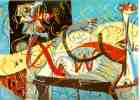 Stenographic Effigy
Stenographic Effigy
1942 (180 Kb); Oil on canvas, xl x 56 in; The Museum of Mod Fine art, New York
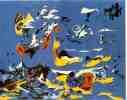 Bluish (Moby Dick)
Bluish (Moby Dick)
c. 1943 (150 Kb); Gouache and ink on limerick board, 18 3/4 10 23 seven/eight in; Ohara Museum of Art, Kurashiki
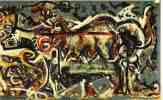 The She-Wolf
The She-Wolf
1943 (230 Kb); Oil, gouache, and plaster on canvas, 41 vii/viii x 67 in; The Museum of Modern Art, New York
 Eyes in the Heat
Eyes in the Heat
1946 (320 Kb); Oil on canvas, 54 x 43 in; Peggy Guggenheim Drove, Venice
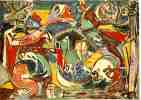 The Key
The Key
1946 (270 Kb); Oil on canvass, 59 x 84 in; The Art Institute of Chicago
 The Tea Cup
The Tea Cup
1946 (230 Kb); Oil on canvas, forty ten 28 in; Collection Frieder Burda, Baden-Baden
 Shimmering Substance
Shimmering Substance
1946 (280 Kb); Oil on sail, 30 1/8 x 24 1/4 in; The Museum of Modern Art, New York
![]() Total Fathom Five
Total Fathom Five
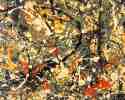 Number eight, 1949 (detail)
Number eight, 1949 (detail)
1949 (280 Kb); Oil, enamel, and aluminum pigment on canvas; Neuberger Museum, Land University of New York
![]() Lavander Mist: Number 1, 1950
Lavander Mist: Number 1, 1950
 Easter and the Totem
Easter and the Totem
1953 (150 Kb); Oil on sail, 84 1/four x 58 in; The Museum of Modern Fine art, New York
During the 1950s Pollock continued to produce figurative or quasi-figurative black and white works and delicately modulated paintings in rich impasto also as the paintings in the new all-over style. He was strongly supported by advanced critics, but was also subject to much abuse and sarcasm equally the leader of a however niggling comprehended manner; in 1956 Fourth dimension magazine called him `Jack the Dripper'.
By the 1960s, yet, he was generally recognized equally the nigh important figure in the most important movement of this century in American painting, only a movement from which artists were already in reaction (Post-Painterly Abstraction). His unhappy personal life (he was an alcoholic) and his premature death in a car crash contributed to his legendary condition. In 1944 Pollock married Lee Krasner (1911-84), who was an Abstract Expressionist painter of some distinction, although it was merely subsequently her hubby'due south death that she received serious critical recognition.
Breaking the ice
It was Jackson Pollock who blazed an astonishing trail for other Abstract Expressionist painters to follow. De Kooning said, ``He broke the ice'', an enigmatic phrase suggesting that Pollock showed what art could go with his 1947 drip paintings.
Information technology has been suggested that Pollock was influenced by Native American sand paintings, made by trickling sparse lines of colored sand onto a horizontal surface. It was not until 1947 that Pollock began his ``action'' paintings, influenced by Surrealist ideas of ``psychic automatism'' (straight expression of the unconscious). Pollock would set up his canvas to the flooring and drip paint from a can using a variety of objects to manipulate the paint.
The Moon-Woman Cuts the Circumvolve (1943; 109.5 10 104 cm (43 x 41 in)) is an early Pollock, merely it shows the passionate intensity with which he pursued his personal vision. This painting is based on a Northward American Indian myth. It connects the moon with the feminine and shows the creative, slashing power of the female psyche. It is not piece of cake to say what we are actually looking at: a face rises earlier us, vibrant with ability, though perhaps the epitome does not benefit from labored explanations. If we tin respond to this art at a fairly primitive level, then nosotros tin also respond to a great abstruse piece of work such as Lavender Mist. If we cannot, at least we can appreciate the fusion of colors and the Expressionist feeling of urgency that is communicated. Moon-Woman may be a feathered harridan or a bang-up abstract pattern; the bespeak is that it works on both levels.
Action painting
� 16 Jul 2002, Nicolas Pioch - Top - Up - Info
Thanks to the BMW Foundation, the WebMuseum mirrors, partners and contributors for their back up.
Source: https://www.ibiblio.org/wm/paint/auth/pollock/
0 Response to "Jackson Pollock Male and Female Philadelphia Museum of Art"
Post a Comment